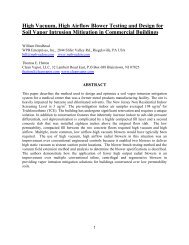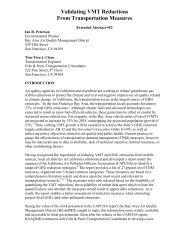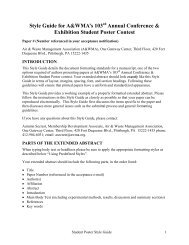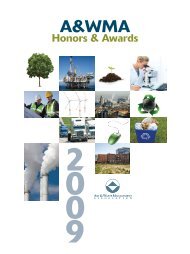Abstract Book
Abstract Book
Abstract Book
Create successful ePaper yourself
Turn your PDF publications into a flip-book with our unique Google optimized e-Paper software.
The Northwest Ports Clean Air Strategy is a cornerstone of the Port of Seattle Seaport Air<br />
Quality Program. The Strategy is a voluntary, collaborative effort of the Ports of Seattle,<br />
Tacoma, and Vancouver (B.C.) to reduce diesel and greenhouse gas emissions from<br />
maritime-related activities in the greater Georgia Basin/Puget Sound region. The<br />
Strategy, which was adopted by the Port of Seattle Commission in January 2008,<br />
establishes Short-term (by 2010) and long-term (by 2015) emissions reduction objectives<br />
have been established for ocean-going vessels, cargo handling equipment, rail, trucks and<br />
vehicles, and harbor vessels. Unlike prescriptive approaches, the Strategy takes into<br />
account the many differences in port operations and allows for customers and tenants to<br />
choose those strategies that are most cost-effective for their particular business models.<br />
The strategy has three primary emissions reduction objectives:<br />
1. Reduce maritime and port-related air quality impacts on human health, the<br />
environment, and the economy<br />
2. Reduce contribution to climate change through co-benefits associated with<br />
reducing air quality impacts<br />
3. Help the Georgia Basin/Puget Sound Airshed to continue to meet air quality<br />
standards and objectives<br />
The Port of Seattle began the Green Gateway initiative in 2006. The Port of Seattle the<br />
Seattle-Tacoma International Airport, a seaport, commercial and recreational marinas,<br />
three container terminals, and the Fishermen’s Terminal. Committed to environmental<br />
leadership, the Port has implemented sustainable business practices in each of its<br />
divisions.<br />
This paper will discuss the Port’s Green Gateway program in air quality, climate and<br />
sustainability.<br />
Port Metro Vancouver - A Leader In Port Sustainability (205)<br />
D. Desjardin, C. Rigby, G. Olszewski; Port Metro Vancouver, Vancouver, BC, Canada<br />
Port Metro Vancouver is the largest port in Canada and the most diverse port in all of<br />
North America, with 28 cargo terminals, 2 cruise terminals and a number of smaller<br />
facilities. The port’s jurisdiction includes 600 km of coastline bordering on sixteen<br />
municipalities and includes Roberts Bank, Burrard Inlet and the Fraser River. It is Port<br />
Metro Vancouver’s vision to be a leader in port sustainability.<br />
Port Metro Vancouver contributes significantly to the local, regional and national<br />
economies through domestic and international trade. Emissions that contribute to air<br />
quality and climate change are a direct result of port operations, from ocean going vessels<br />
and tugs to cargo handling equipment, trucks and locomotives among other sources. The<br />
port recognizes that impacts to human health, the environment and the economy are<br />
occurring as a result of air quality and climate change and that port emissions have the<br />
potential to grow due to increasing trade demands. As a result Port Metro Vancouver is<br />
committed to reducing emissions of criteria air contaminants and greenhouse gases.<br />
The port and its stakeholders have undertaken a number of air emission reduction<br />
initiatives ranging from the international and collaborative Northwest Ports Clean Air<br />
22












